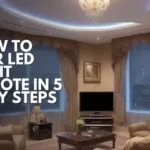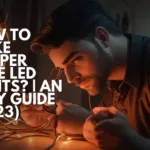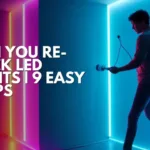If you’re looking to add a cozy or vibrant touch to your living space, LED lights are your go-to tool for interior design. And guess what? You can do it without using any sticky adhesives! We’ve got some clever methods up our sleeves, from double-sided tape to magnetic solutions, that will securely attach your LED lights to your walls hassle-free.
How to Stick LED Lights on Wall Without Adhesive

If you’re keen on decking out your space with LED lights but prefer to avoid adhesive how to stick led strip lights on wall without damaging paint, no problem! We’ve got you covered with these meticulously explained methods:
1. Double-sided tape:
This method is a breeze! Get your hands on a top-notch roll of double-sided tape. Cut a piece to fit the length of your LED strip, affix it to the back, then peel off the other side and stick it to the wall. Apply some firm pressure, and voilà! This tape ensures a secure hold over time.
2. Command Strips:
These little wonders are a game-changer. They’re small adhesive strips that can be removed without leaving a trace. For this, follow the instructions on your specific brand of Command strips. Generally, peel off the backing, attach it to the back of your LED strip, then remove the other half of the strip and press the LED light firmly into place.
3. Velcro Strips:
Another fuss-free option! These strips are removable and won’t leave any residue behind. Attach one side to the back of your LED strip, then peel and stick it to your chosen location. Give it a solid press, and you’re good to go!
4. Magnets:
If flexibility and easy removal are your priorities, this is the way to go! Attach magnets to the back of your LED strip, position it where you want, and press the magnets firmly into place. It’s a fantastic option for those concerned about potential wall damage.
5. Hooks or Nails:
For a more permanent setup, consider using hooks or nails. Mark the spots on the wall, screw the nails or hooks in, and then loop the LED strips around them. This method ensures a secure, long-lasting hold.
6. Wireless Receivers:
These nifty little gadgets can be easily attached to the back of your LED strip light and then clipped onto a surface. They’re a great option for those who prefer temporary setups or would rather avoid dealing with adhesive.
7.Cups:
These handy cups can be affixed to the back of your LED strip light and then securely suctioned onto a surface. They’re a fantastic choice for those who want a temporary installation or simply prefer to avoid adhesive.
8 .Zip Ties:
These small, plastic ties are perfect for securing your LED strip light to a surface. They’re ideal for permanent installations or for those who’d rather not use adhesive.
9.Magnetic Tape:
This special tape comes with magnetic properties, making it a breeze to attach your LED strip light to a surface without the need for adhesive. It’s a convenient alternative for those seeking a secure yet removable option.
There you have it! Whether you’re aiming for a temporary setup or a more permanent fixture, these methods have got you covered.
Read More : How to Pair LED Light Remote in 5 Easy Steps
How do I choose the right color temperature for my room?

Picking the perfect color temperature for your room can be a bit of a puzzle, but it’s totally worth it. You see, the type of light can seriously affect the mood and vibe of a space, not to mention your productivity and how well you catch those Z’s at night.
Color temperature is measured in degrees Kelvin (K) and it goes from warm to cool. Warm light has a lower color temperature (around 2700K) and gives off that cozy yellow or orange glow. On the flip side, cool light has a higher color temperature (about 5000K) and brings out that crisp blue or white shine.
Read More: How To Fix LED Lights When The Colors Are Wrong (5 Easy Steps)
Here are some friendly pointers for getting the right color temperature in different rooms:

Bedroom: If you’re all about creating a snug and chill atmosphere, go for warm white light with a color temperature of around 2200K to 2700K.
Living Room: Want that lively and peppy feel? Opt for cool white light with a color temperature of around 4000K to 5000K.
Bathroom: For that fresh and vibrant vibe, aim for daylight white light with a color temperature of around 3000K.
Read More: Can You Sleep With LED Strip Light ON|Reasons and Solution (2023)
Conclusion:

In the pursuit of transforming our living spaces into cozy havens or vibrant sanctuaries, LED lights have emerged as a versatile tool for interior design.
However, for those seeking to illuminate the surroundings without the use of adhesive, there are several ingenious methods to consider. From double-sided tape to magnetic solutions, each technique offers a secure and hassle-free way to affix LED lights to walls. In this guide, we’ll walk you through these meticulously explained methods, ensuring you can brighten up your space without the need for adhesives.
Read More: Can you Re-Stick LED lights | 9 Easy Steps
FAQ:
1.What are the different ways to stick LED lights on a wall without adhesive?
Sure thing! There are a multiple ways you can do this:
a. Mounting clips: They’re like little holders made just for LED strips. They come in various shapes and sizes, so you can pick the ones that fit your needs best.
b. Mounting putty: This is a special kind of putty that sticks to walls without leaving any marks. It’s great for more delicate or painted surfaces.
c. Cable ties: You can use these to attach LED strips to things like furniture, shelves, or pipes. Handy if you’d rather not attach them directly to the wall.
d. Staples: If you’re dealing with a wooden wall, staples can be used to hold the LED strips in place. Just be sure to pick staples that match the thickness of your LED strips.
2 .Which method is best for me to Stick LED Lights On Wall Without Adhesive ?
It really depends on your specific situation. If you want a quick and easy solution, mounting clips or cable ties might be your best bet. But if you’re looking for a more long-term fix, mounting putty or staples could be the way to go.
3. How do I prepare the wall before sticking the LED lights?
Before you start, make sure your wall is nice and clean. Give it a wipe down if it’s dusty or dirty. Then, use a level to mark where you want the LED lights to go.
If you’re using mounting clips or staples, you might need to do a bit of drilling. Just be sure to use the right drill bit for your wall type.
How do I stick the LED lights to the wall?
a. Once your wall is prepped, it’s time to get those lights in place! Just follow the instructions that come with your LED lights or mounting gear.
b. For mounting clips, snap them onto the LED lights and then screw them into the wall. If you’re using a mounting putty, apply a little to the back of the lights and press them against the wall.
c. For cable ties, wrap them around the LED lights and secure them to something on the wall. And if you’re using staples, just staple the lights right onto the wall.
4. How do I test the LED lights?
After everything’s set up, plug them in and flip the switch to make sure they’re working like they should. If they don’t light up, double-check the connections to be sure everything’s snug.
5. How do I remove the LED lights from the wall?
If you ever need to take them down, be gentle to avoid any damage.
For mounting clips, unscrew them from the wall. With the mounting putty, gently peel it away. If it’s cable ties, just snip them with scissors. And for staples, use a staple remover to take them out.
6. What are some tips for sticking LED lights on a wall without adhesive?
Here are a few handy tips:
*Make sure the wall is clean and dry before you stick the lights on.
*Use the right mounting gear for your wall type.
*Test the lights before you peel off the backing from the adhesive.
*When removing them, be careful not to damage the wall or the lights.










